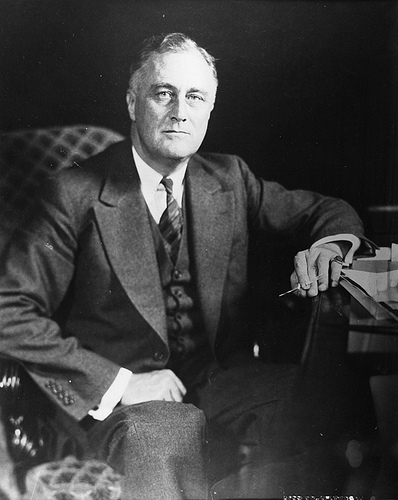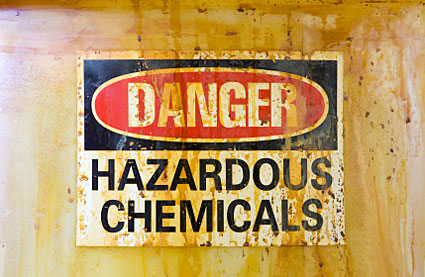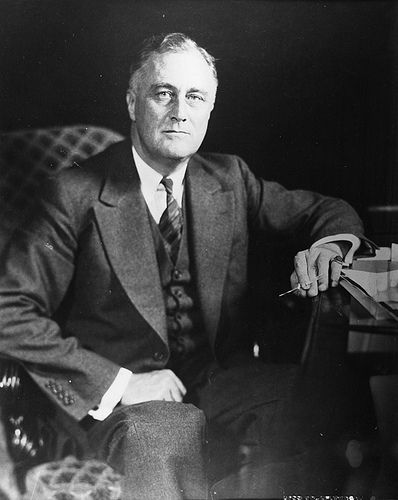Cross-posted from New Deal 2.0.
 Franklin D. RooseveltPhoto: uncgspecial via FlickrIn the wake of recent revelations that far more oil is spilling out into the Gulf than was originally estimated, and as it now appears more and more likely that BP will not be able to completely shut off the flow of oil until perhaps as late as August, fears about the economic impact of the disaster have intensified. With roughly a third of the federal waters in the Gulf closed to fishing, the seafood industry has perhaps been the hardest hit by the disaster. But tourist bookings as far away as Florida are down as well, with some hotels reporting a 50 percent cancellation rate.
Franklin D. RooseveltPhoto: uncgspecial via FlickrIn the wake of recent revelations that far more oil is spilling out into the Gulf than was originally estimated, and as it now appears more and more likely that BP will not be able to completely shut off the flow of oil until perhaps as late as August, fears about the economic impact of the disaster have intensified. With roughly a third of the federal waters in the Gulf closed to fishing, the seafood industry has perhaps been the hardest hit by the disaster. But tourist bookings as far away as Florida are down as well, with some hotels reporting a 50 percent cancellation rate.
Then there is the energy industry. In spite of the oil catastrophe, the Obama administration’s decision to halt shallow drilling until new safety regulations are in place and to enforce a minimum six month moratorium on deep water drilling has come under growing criticism — even from some lawmakers — because of its potential impact on jobs. Indeed, in an interview today on PBS’s NewsHour, Senator John Barrasso (R-Wyo.) of the Senate Energy and Natural Resources Committee echoed the concerns of his colleague, Senator Mary Landrieu (D-La.), when he said that he agreed with her assessment that “even a temporary pause” in offshore drilling would “hurt the economy at a time when we’re dealing with 9.7 percent unemployment in this country.”
This notion — that in hard times environmental issues must take a back seat to economic concerns — is a myth that environmentalists have struggled with for decades. What is less well known is that FDR was the one president who did more to face this false dichotomy and in the process develop a whole new approach to human interaction with the environment. It was Roosevelt, after all, who had to deal with the twin crises of the collapse of the U.S. economy and the environmental catastrophe known as the Dust Bowl. And, as a man raised in the pastoral countryside of the Hudson River Valley, who possessed a deep appreciation for the productivity of the land and an equally strong belief — like Thomas Jefferson before him — that democracy had its roots in the fundamental ties between the people and the land, watching the soil of the Midwest blow away in the wind tore at his very being. Indeed, for FDR the collapse of the economy and the environmental degradation of the land in the Midwest and in other parts of the country were intimately linked; so much so that he remained convinced throughout these years that it would be impossible to restore one without restoring the other.
As a consequence, and as the environmental historian, Richard N.L. Andrews, has written, “Roosevelt’s personal vision of integrating economic and environmental restoration” became one of the core principles of the New Deal. “No other President,” he insists, “has focused so personally or effectively on the restoration of environmental damage, nor on the principle that such restoration is integral and beneficial to economic recovery rather than in conflict with economic priorities.”
For many years, of course, the New Deal — with its dam building and emphasis on the use of administrative expertise as opposed to judicial oversight in its approach to the environment — was seen as something of a blank space in the history of modern environmentalism. But in recent years this view has changed dramatically. Having recognized that in a world of limited natural resources human interaction with nature is inevitable, modern environmentalists, like FDR, have come to see the environment not as a realm set apart from humans, but as the field for human action, inextricably linked with the human community, economy, and system of values. For FDR then, restoring the environment and restoring the economy were part of the same process; a process that he began within days of assuming office. One of the hallmarks of this effort was the creation of the Civilian Conservation Corps (CCC) on March 31, 1933, less than a month after his inauguration. This was followed shortly thereafter by the establishment of the Tennessee Valley Authority (TVA), which represents the Roosevelt Administration’s first great effort in regional planning. The TVA took the unusual step of combining public power and conservation in an area comprised of nearly 300,000 acres of land in seven states. Its immediate purpose was to control flooding in the vast area of the Tennessee River and its tributaries through the construction of a series of dams and reservoirs; but it also improved river navigation, generated electricity, and sought to restore a vast watershed decimated by excessive timber cutting, irresponsible farming, and largely unregulated coal mining through soil conservation and reforestation. In the process it also provided jobs for thousands of workers, including 6,000 from the CCC alone.
This multipurpose approach to solving both an environmental and economic problem can be seen in the work of the CCC as well. Between 1933 and 1942, when the program ended, the CCC planted over 3 billion trees (including the vast shelterbelt from Texas to the Dakotas that brought the Dust Bowl to an end), constructed roughly 100,000 miles of road, restored 80 million acres of farmland, laid hundreds of miles of telephone lines, created nearly 800 state parks, and restored nearly 4,000 historic buildings. In total, it employed more than three million individuals (who enlisted in the program for a minimum of six months), mostly from blighted urban areas, who were required to send the majority of their pay ($25 out of the $30 they were paid monthly) back home to help support their families. In this way, the program became a means both to restore rural as well as urban America. The CCC built libraries for the camps and offered its workers classes (with a 90 percent enrollment rate), and taught more than 100,000 men how to read and write. It was also perhaps the most popular program of the New Deal (with an over 80 percent approval rating from the American public) and would help inspire later generations to establish such programs as the Peace Corps and Americorp.
Both the TVA (which is still in operation today) and the CCC were federally funded programs established within the first hundred days of the Roosevelt presidency. They were inspired by the belief that in times of environmental and economic crisis, the federal government can and must act aggressively in the public interest. They were also enormously successful in achieving their fundamental aims of helping to restore the social, economic, and environmental well-being of vast regions of the country. As we try to come to terms with this new environmental catastrophe that has unfortunately struck a critical region of the nation, there are certainly lessons that can be drawn from these two extraordinary and unprecedented programs that emerged in the New Deal. Our experience in the Gulf to date has proven that mere government oversight of a largely private sector effort to deal with this disaster will not be enough. Nor should we fall victim to the false view that such a catastrophe is the unfortunate but inevitable consequence of the paramount need for energy and economic development in a time of high unemployment. Franklin Roosevelt once said that those who allow or purposely destroy the natural resources of a region should also be seen as destroyers of “the liberty of the community … destroyers of his neighbor’s happiness [and] prosperity.” British Petroleum has destroyed the liberty of the Gulf Coast community, but to restore this region to its full health the federal government should take a lesson from the New Deal and act much more forcefully in the public interest. The American people understand this. They are ready and eager to do whatever it takes to make this region whole again and in all likelihood would support a comprehensive, multifaceted federally funded effort to clean up the Gulf coast along the lines of the CCC and TVA.
One gets the sense that President Obama knows this, as it was less than a year ago that he reflected on the “large-heartedness” of the American people, of their ability “to stand in other people’s shoes,” of their belief “that in this country, hard work and responsibility should be rewarded by some measure of security and fair play; and an acknowledgment that sometimes government has to step in to help deliver on that promise.” For the inhabitants of Gulf Coast there is no question that such a time has arrived. The president should heed his own words and deliver. It times of great crisis the American people expect no less.



